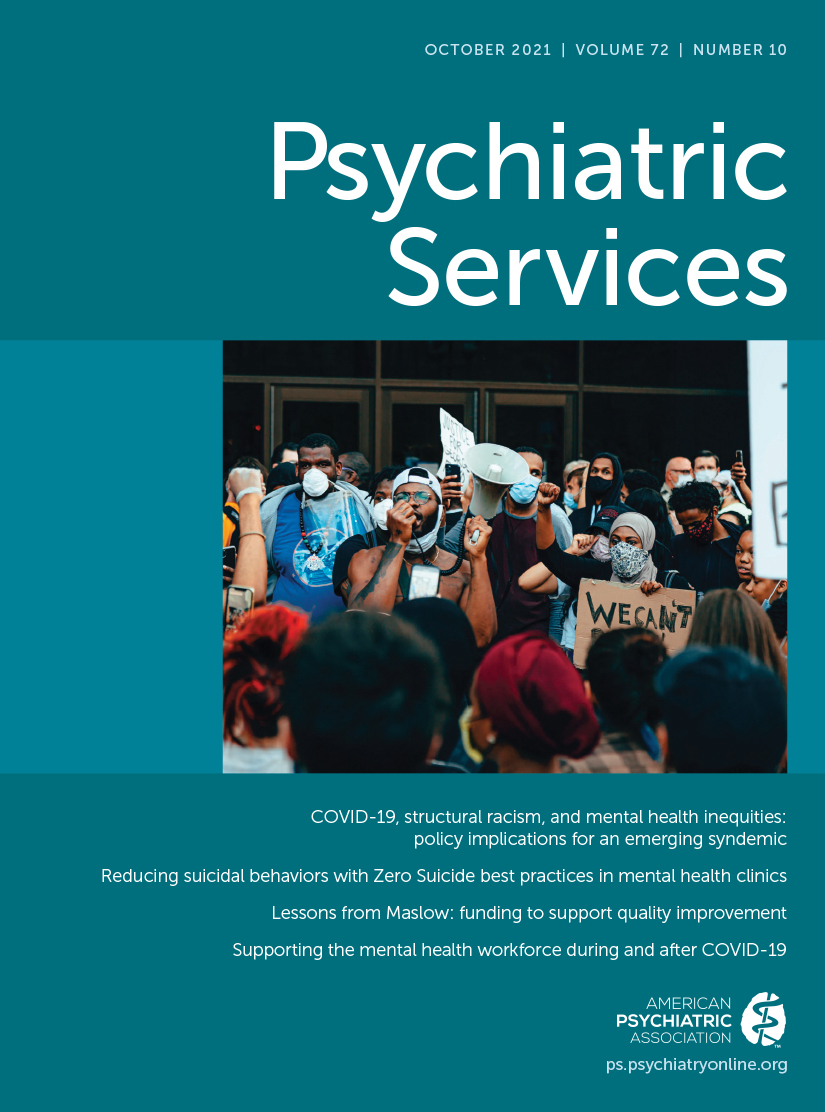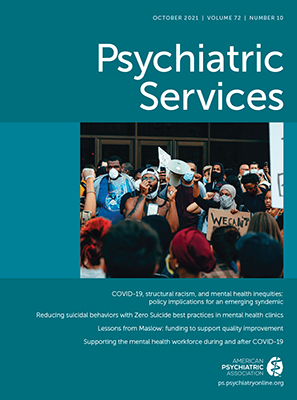The COVID-19 pandemic has catalyzed unprecedented changes in the public mental health sector. These changes include a shift toward virtual modalities of treatment, financial strain for community mental health organizations, and environmental and workflow changes in inpatient and community-based settings (
1). As restrictions imposed during the initial phase of the pandemic are gradually lifted, many of these clinics are now recalibrating workflows, anticipating possible new outbreaks, and planning for the “new normal” of care delivery.
Much of the support available to public-sector providers in the United States is offered in the form of government-funded technical assistance. Technical assistance represents a continuum of activities, ranging from basic education and training to targeted, time-limited consultation and learning through intensive implementation support, aimed at helping organizations to implement and sustain evidence-based treatments (
2). Technical assistance is most commonly provided by intermediary and purveyor organizations, specialized entities that support either a single evidence-based practice (purveyor organizations) or multiple practices (intermediary organizations) (
3).
The successful implementation of evidence-based interventions is affected by factors at multiple levels both within and outside mental health organizations. These factors include characteristics of the intervention; the economic, political, and social context in which an organization resides (outer setting); the structure, leadership, and culture of the organization (inner setting); the service users, clinicians, or managers who will be delivering the intervention; and the process by which the intervention is implemented (
4). The COVID-19 pandemic has created change in nearly all of these domains (
5), including modifications to the regulatory and fiscal environment, institution of new workflows and job roles within provider organizations, risk of burnout and turnover among clinicians, and a shift from in-person to virtual delivery of many evidence-based services.
In this Open Forum, we consider how technical assistance organizations have supported community mental health providers and organizations in adapting to these changes. We focus on three domains that could have a lasting effect on community mental health care: the shift from in-person to virtual treatment, which affects how services are delivered; changes in regulations and financing, which affect service uptake and sustainability; and well-being and burnout among clinicians who provide the treatments. We provide illustrative examples from SMI Adviser, a national intermediary organization funded by the Substance Abuse and Mental Health Services Administration that provides technical assistance to individuals, families, and clinicians who treat people with serious mental illnesses.
Telehealth and Telesupervision
The COVID-19 pandemic has catalyzed a rapid shift from in-person services to the use of video communication across a range of hospital, residential, and outpatient settings (
6). Many clinicians who had limited experience or training in telehealth services before the pandemic are now providing the bulk of their care remotely.
Although some competencies developed by mental health clinicians for in-person services translate to telehealth, others require new skill sets. Existing guidelines for training competencies (
7) have required tailoring to the evolving regulatory and practice environment, including teleprescribing and privacy regulations (
8). As clinics reopen for in-person care, providers will need guidance to determine which patients are most appropriate for ongoing telehealth care and how best to combine virtual and in-person visits.
Parallel to changes in clinical care delivery, physical distancing requirements related to COVID-19 have precipitated a shift toward a virtual workplace for public-sector mental health clinicians. Staggered work schedules and physical distancing protocols have reduced in-person interaction among both staff in the workplace and those working from home. Many staff supervision sessions and meetings have shifted from in-person to tele- and videoconferencing.
Telesupervision can improve access to qualified supervisors, particularly for rural and underserved providers, with effectiveness comparable to in-person contact (
9). However, as with telehealth, effective telesupervision also depends on supervisor competencies, effective communication strategies, and technological skills (
9). These competencies will need to be updated to incorporate the more widespread use of virtual workplaces, with fewer opportunities for in-person contact among staff between telesupervision sessions.
The widespread shift toward telehealth and telesupervision has created a need to incorporate these approaches into training programs and continuing education offerings and to help frontline clinicians and patients to gain telehealth skills and competencies during the COVID-19 pandemic. SMI Adviser has offered webinars and provided updated information on telehealth privacy regulations and reimbursement strategies, guidance for clinicians and patients in preparing for telehealth sessions, and virtual learning collaboratives to help clinicians adopt telehealth and digital technology. Moving forward, SMI Adviser will be incorporating “bite-size” videos and interactive, technology-based learning formats to continue helping providers gain and use core telehealth and telesupervision skills. We are also developing training programs and certifications for clinic staff to support patients in navigating and using telehealth and other digital technologies. Real-time, geolocated information on website usage and downloads of educational materials provide data on programmatic reach and geographic gaps for these telehealth technical assistance activities.
Addressing Fiscal Challenges
Many community mental health organizations are facing unprecedented fiscal challenges as a result of reduced patient volume, changing payer case mix, and state budget cuts. In a June 2020 survey of state mental health commissioners, 71% of those responding reported workforce shortages because of the pandemic, 73% reported that community providers had reduced staff or services, and 20% reported closures of community providers in their states (
10).
Fiscal uncertainty among community mental health organizations has created understandable anxiety for public-sector clinicians regarding their job and financial security as well as future career planning. Many clinicians are simultaneously facing the need to adapt to new workflows and the possibility of layoffs or salary reductions. These new financial issues may exacerbate long-standing problems of inadequate pay for community mental health providers (
11). Higher salaries and opportunities for job advancement are important factors driving retention for community health workers (
12); both will be more difficult to provide to clinicians in a constrained fiscal environment. Providers such as nurse practitioners who see their jobs as portable may seek employment in other mental health or health care settings.
While the current crisis has resulted in short-term funding challenges for community mental health organizations, it has also created new opportunities for billing for telehealth and telephonic services, more efficient workflows with fewer no-show visits, and opportunities for more flexible clinic hours (
1). Technical assistance with billing and financing can help public-sector organizations and clinicians adopt not only best clinical practices but also best management and fiscal practices that will allow them to remain solvent and recruit and retain high-quality staff (
13).
Moving forward, organizations will need support in understanding regulatory and billing policies, assistance with redesigning workspaces as more staff provide telehealth services from home, and guidance on remote delivery of evidence-based practices (
8). SMI Adviser has developed tip sheets and tool kits to assist with telehealth billing and implementation and provided one-on-one consults to provide clinicians and managers with guidance tailored to their local practice settings. Program evaluation surveys distributed after each activity, questions regarding additional educational needs, and follow-up surveys are measuring implementation of these activities.
Preventing and Addressing Burnout
The aforementioned challenges of new workflows, job insecurity, and isolation from colleagues all pose risks of job burnout among health care providers (
14). Even before the COVID-19 pandemic, surveys documented high levels of burnout among psychiatrists, with those working in community settings at particularly high risk (
15). Burnout not only affects staff morale and retention but can also adversely affect quality and safety of patient care (
16).
Interventions addressing provider burnout fall into two broad categories: those targeting stress and coping among individual providers and those facilitating organizational changes, which help organizations to address provider workload, foster communication among providers, and cultivate a sense of teamwork. These two approaches can each be effective, and combining them may provide synergistic benefits in addressing provider burnout (
17).
The major structural changes occurring within the mental health system suggest that organizationally focused interventions will be particularly important for preventing and addressing burnout related to the COVID-19 pandemic. SMI Adviser has provided intensive implementation support to public-sector provider organizations to help them improve quality of care and staff retention. This support has included guidance on restructuring workflows and redeploying and better utilizing existing staff. Active, ongoing engagement with state mental health authorities, community provider organizations, and professional groups both inform this work and make it possible to disseminate the findings to the field.
Technical Assistance in a Postpandemic World
The changes brought about by the COVID-19 pandemic have required community mental health provider organizations to innovate in how they provide care and intermediary and purveyor organizations to innovate in how they deliver technical assistance. Because the evidence base for many of these activities is still emerging, technical assistance activities have needed to balance expert training and consultation with forums for community providers to share emerging best practices and challenges. Moving forward, knowledge gained through this work can help to build the body of practice-based evidence to inform future technical assistance activities in a postpandemic world.

